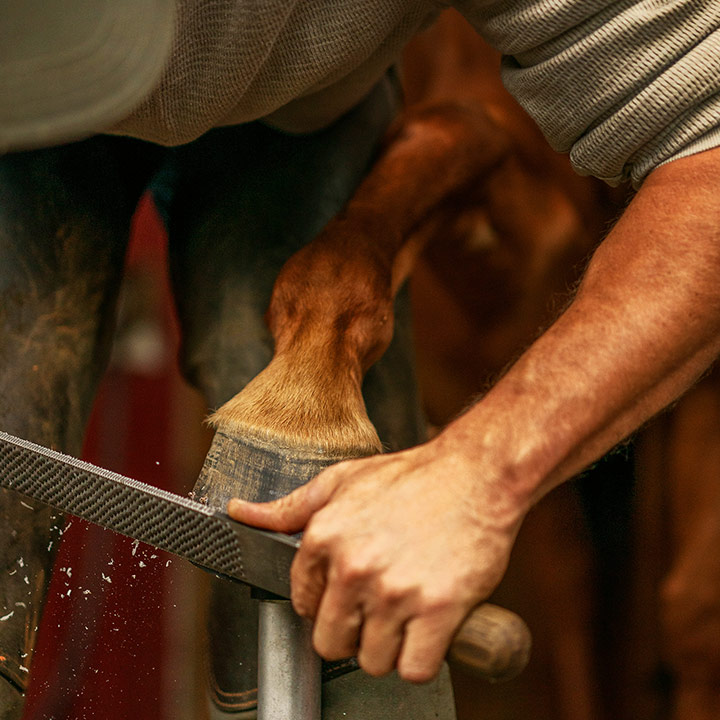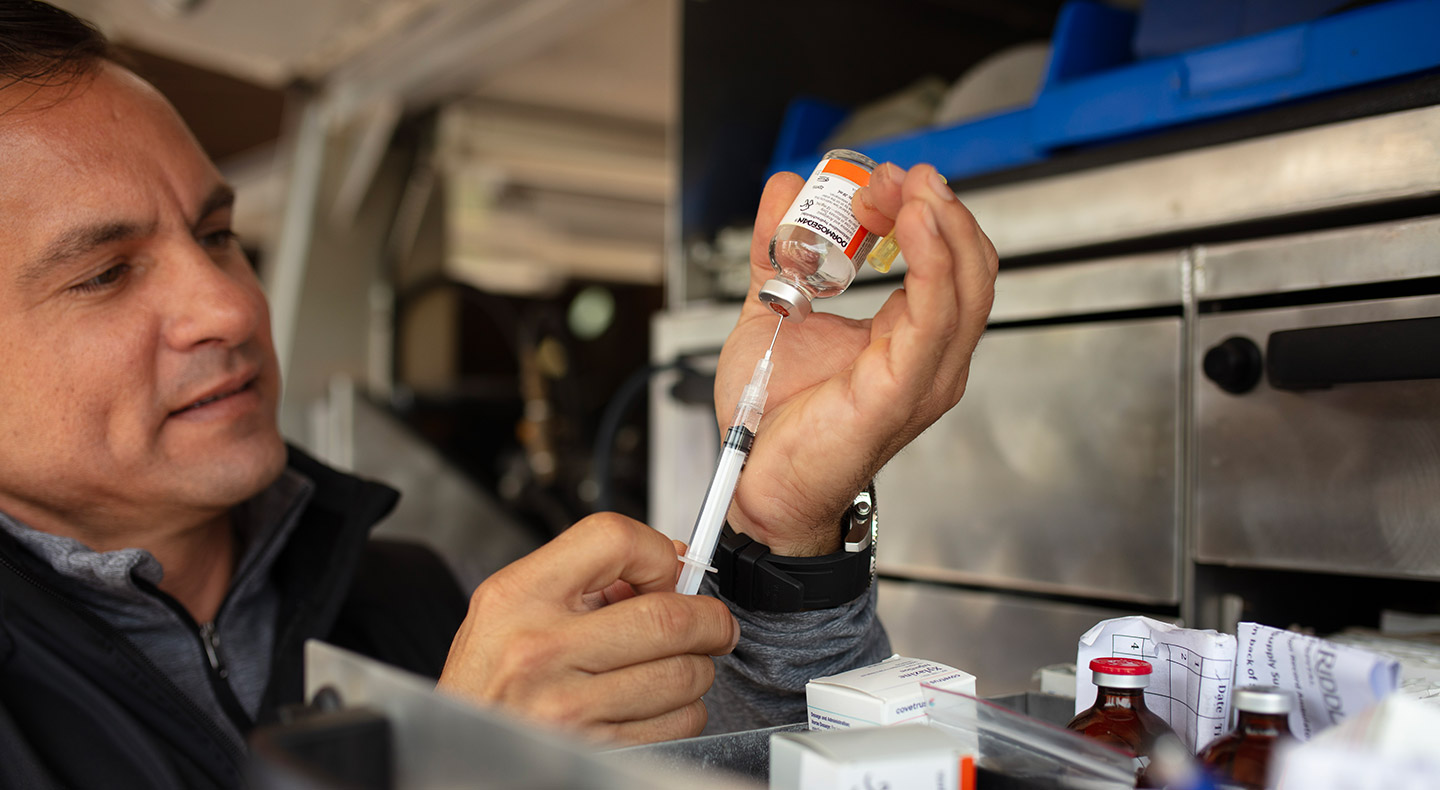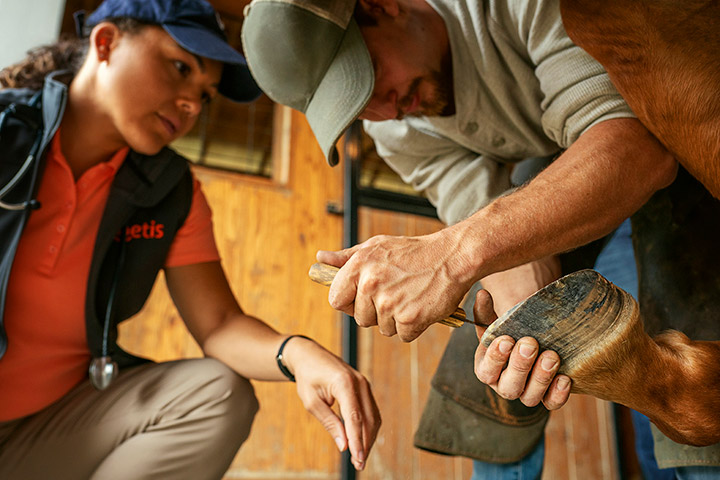Equine Sedation: A Comprehensive Guide for Horse Owners
Jeff Hall, DVM, Managing Equine Technical Services Veterinarian, Zoetis
6/10/2025



If the thought of sedating your horse makes you nervous or uncomfortable, you’re not alone. Many horse owners feel anxious about the idea, but the truth is that sedatives are commonly used, safe and often easy to administer.
In many cases, sedation isn’t just helpful—it’s essential. Horses are powerful animals, and their size and fight-or-flight mentality can make for particularly dangerous situations for themselves and those around them if they’re startled, anxious, scared or uncomfortable. Additionally, there are parts of a horse that are not physically visible or accessible to a veterinarian, such as their teeth, unless the horse is sedated and relaxed.
When used appropriately, sedatives increase a horse’s comfort in stressful situations, helping to ensure your safety and that of the veterinarians and handlers working with them.
In this blog, I provide an overview of what horse owners need to know about sedation, including the different types of common sedatives and how they’re administered, when and why they’re used, what to expect during the process, and how to partner with your veterinarian to provide the best care and pain management for your horse.
Let’s get started!
Types of common equine sedatives and what to expect
When people hear the word “sedation” they tend to think of a loss of consciousness, likely due to medical procedures they or their family members have undergone. But sedatives that cause a loss of consciousness, referred to as general anesthetics, are reserved primarily for equine surgical procedures. The majority of equine sedatives do not cause a loss of consciousness but instead help the horse be more relaxed and less sensitive.
An easy-to-understand way to break down the types of sedatives is by their method of administration. Broadly, they can be organized into three categories:
Oral sedation: Prescribed by veterinarians for horse owners to administer
The two most common drug types given by mouth for standing sedation are alpha-2 agonists and phenothiazines. They provide mild to moderate levels of sedation that help reduce a horse’s anxiety and awareness. The horse remains upright and conscious. Oral sedation typically takes longer to take effect since it needs to be absorbed through the gum tissue or intestinal tract into the circulatory system. The effects may last for an extended period of time, depending on the sedative type and dosage.
Acepromazine is a phenothiazine that works by blocking dopamine receptors in the horse’s central nervous system, which regulates alertness, resulting in moderate sedation. The effects of acepromazine can be variable depending on the horse and formulation, and it typically doesn’t result in as deep or long sedation as an alpha-2 agonist like Dormosedan® Gel (detomidine hydrochloride).
Dormosedan Gel acts by binding to alpha-2 adrenergic receptors, relaxing the muscles and reducing anxiety. Detomidine hydrochloride is the most potent alpha-2 agonist available for horses, meaning a little goes a long way. Dormosedan Gel is the first and only sedative approved by the FDA specifically for horse owner administration. It’s an oral mucosal gel administered under the tongue. Xylazine is another commonly used alpha-2 agonist that you might be familiar with. It’s sold both generically and under brand names like Rompun.

Oral sedatives like Dormosedan Gel have a wide range of uses cases, including the following:

- Routine care: Oral sedatives can make routine husbandry procedures less stressful for horses and handlers. Think sheath cleaning, bandage changing, clipping, mane pulling or corrective farrier work for a difficult situation.
- Fireworks: Fireworks and other loud, uncontrolled events can spook horses and lead to injury. Using light sedatives ahead of events like this helps ensure your horse stays calm, avoiding injury.
- Unfamiliar environments: Sedatives can help lower stress and anxiety and increase comfort in new environments. They can also promote positive reenforcement around activities like trailer loading, though horses should never be trailered when sedated without a veterinarian’s guidance.
- First turnout after injury: If your horse has been on stall rest after an injury, they may have pent-up energy they’re eager to expend. Sedation can help ensure they don’t reinjure themselves during those first few small paddock turnouts.
What to expect when administering Dormosedan Gel
Pre-sedation
- You must have a veterinary client-patient relationship in order for your veterinarian to prescribe Dormosedan Gel for your horse. This means your veterinarian must have completed a physical examination on your horse (including listening to their heart) within the last year. Speak with your veterinarian about what you need help with to see if Dormosedan Gel is the right fit. They can also determine what dosage to use based on body weight and answer any questions or concerns about administration.
Administration
- Dormosedan Gel comes in a single-dose syringe and the dose can be dialed up by twisting the ring on the plunger to the right level based on body weight.
- Ensure there’s no hay or grass in your horse’s mouth prior to administration.
- Wear disposable latex gloves when handling or administering Dormosedan Gel.
- To work properly, it’s crucial that Dormosedan Gel be administered under the tongue. Remove the end cap and place the open tip of the tube under the horse’s tongue in the bar region (where the bit sits) and depress the plunger until it hits the ring stopper.
- Dormosedan Gel is absorbed through the oral mucosa and, unlike a dewormer, won’t work if swallowed, which can happen if the gel is administered on top of the tongue or at the back of the mouth.
- Once administered, restrict access to hay and water and leave your horse in a quiet, clean stall or safe area where you will be working until sedation has taken effect.
- For best results, allow adequate time (a minimum of 40 minutes) between administration of the gel and its proper effect. Do not bother your horse during this time since it can interfere with the onset of action and depth of sedation.
During sedation
- As sedation begins to take effect, you may observe signs that appear alarming to you but are normal parts of the sedation process. Typically, your horse’s head will slowly start to lower, and their legs may appear unsteady as they try to balance under sedation. You may also notice respiratory noises if their head is low to the ground. Other common signs include swaying, sweating, salivating and muscle tremors. These are all normal and expected and will go away on their own as the sedation wears off.
- Once in effect, Dormosedan Gel will last approximately 90 to 180 minutes.
Post-sedation
- Oral sedatives like Dormosedan Gel typically take longer to work their way out of the horse’s system. It can take between 3 and 4 hours for your horse to fully recover from sedation with Dormosedan Gel.
- Allow your horse to rest in a comfortable, quiet area and withhold food and water until they’ve fully recovered. It’s important to wait until the effects have fully subsided before eating to prevent choking.
How to Dose Dormosedan Gel
Standing intramuscular (IM) sedation: Administered by veterinarians
Typically, IM sedatives are given in the triangular muscular region in the neck, and usage requires knowledge of how to pull up the medication, where and how to insert the needle, how to administer the contents of the syringe (including aspiration to avoid blood vessels) and proper disposal of used materials.
The onset of action for an IM injection is quicker than for orally administered medications, taking 10 to 15 minutes. The duration of effect depends on the medication and dosage used. Your horse will go through similar stages as oral sedation as the sedative takes effect, as well as the same recovery process.
Standing intravenous (IV) sedation: Administered by veterinarians
Standing IV sedatives, which can have the same active ingredients as oral sedatives but a different formulation, are used when a more rapid onset of sedation is desired or higher levels of sedation or control are needed, such as for invasive medical procedures or examinations, dental care, or advanced diagnostics. IV-based solutions tend to go into effect very quickly once the drug is given, usually within 5 minutes.
The most common location for IV sedation is in the jugular vein, which sits on either side of the neck. Given the proximity of the carotid artery to the jugular vein and the potential for major complications, including seizure and death if the drug is inadvertently injected into the carotid artery, IV administration should be reserved for a veterinarian.
Acepromazine, Rompun and and Dormosedan® Sterile Solution (detomidine hydrochloride) are examples of commonly used IV sedatives.

Below are some common situations where your veterinarian would administer IV sedation

Routine care
- Dental examination and floating: Due to the anatomy of the equine skull, it’s very challenging to examine the whole mouth without sedation and a mouth speculum. The noise of the equipment and the feeling of the float or rasp in the mouth can be unnerving for horses, making sedation essential for precise and stress-free dental care.
- Hoof trimming and corrective shoeing: Some horses may have painful conditions such as laminitis that can make it hard to stand on three legs while a farrier works on them. Sedation can make it easier to get the job done quicker, thereby minimizing the time of discomfort.
Medical procedures
- Injuries: In cases of injury, like a wound or laceration, sedation allows the ability for more complete evaluation and repair (along with a local anesthetic to reduce sensation).
- Diagnostic imaging (radiographs, ultrasounds): Horses need to remain still for clear, accurate diagnostic imaging, and sedation helps practitioners effectively image horses the first time around. Additionally, equipment is expensive and needs to be close to the horse to get appropriate images. One kick could be the end of the equipment’s functionality.
- Standing surgical procedures: Sedation allows veterinarians to perform minor procedures such as eye removal, sinus surgery, laparoscopy, and tooth or mass removal so that general anesthesia and recovery can be avoided.
- Joint injections: If your horse receives joint injections for conditions like osteoarthritis, sedation can help ensure the treatment is administered safely and in the appropriate spot.
What to expect when your veterinarian administers Dormosedan Sterile Solution
Pre-sedation
- Your vet will perform a physical exam on your horse, including listening to their heart rate and rhythm. This is important to ensure there are no arrythmias or other abnormalities, which may interfere or need to be accounted for with sedation.
- The dosage will be calculated based on your horse’s body weight, the amount of time needed for the procedure and the type of sedative.
Administration
- After appropriately cleaning the injection site, your veterinarian will inject the sedative into the jugular vein using a sterile needle and syringe. Needles and syringes are single-use only and should not be shared, washed or reused.
- In order to maximize the depth of sedation, a minimum of 5 minutes should be allowed to pass before restraining your horse or beginning any procedure.
During sedation
- As sedation takes effect, you may notice that your horse’s head lowers, the ears point sideways and the muzzle twitches. The head may jerk as they settle into sedation. This is all normal.
- Since Dormosedan is an alpha-2 agonist, giving a higher dose will prolong the duration of sedation by saturating the nerve receptors in horses.
- Your horse may stumble or buckle a leg. This is normal as your horse reaches an adequate level of sedation.
- It’s best to have a handler stand next to your horse and hold the lead rope but not interfere with the sedation process by lifting, patting or tapping their head. Doing so could disrupt the normal progression of sedation and not allow the horse to reach an adequate level of sedation.
- After 5 minutes, your horse’s nose should be lowered, their feet should be planted and their legs should be in a stable stance.
Post-sedation
- The effects of Dormosedan Sterile Solution last approximately 90 minutes to 2 hours, depending on the dosage given. It’s important to allow your horse to rest quietly until the effects have fully worn off and to withhold food and water until they’re back to normal. If your horse is competing, be sure to allow ample time for their recovery and check competition rules around the use of sedatives. Your veterinarian can help with the timing on that.
General anesthesia: Administered by veterinarians
Our last category, general anesthetics, includes the most powerful sedatives available. They’re also administered by IV for induction of anesthesia and may be maintained via a constant rate of infusion through an IV or by gas-inhaled anesthetics through an endotracheal tube using an anesthesia machine that can breathe for the horse. They’re always administered and monitored by a veterinarian and technician, and are usually required for advanced medical or surgical procedures where complete loss of consciousness is needed to complete the procedure, such as castration, colic surgery, arthroscopy, or fracture repair.
While a horse is under general anesthesia, their vital signs need to be continuously monitored through the end of the procedure and during recovery. Depending on the type of procedure performed, horses can recover on grass (like after routine castration), in a padded recovery stall (like after colic surgery), or in a sling or inflatable raft in a pool (like for neurologic or fracture repair cases) depending on the facility and availability.
Make informed choices with your veterinarian
Your veterinarian is always your best resource when it comes to equine health topics, including sedation. Don’t be afraid to be proactive and discuss your concerns by asking questions like:
- Will my horse need to be sedated during the exam or procedure?
- What type of sedative will be used, how does it work and how long will it last?
- How long until my horse can graze, eat or drink after being sedated?
- What’s the withdrawal period for the sedative (important for competing or racing horses)? You can also reference USEF/FEI withdrawal guidelines to ensure you’re following proper protocol.
IMPORTANT SAFETY INFORMATION
Do not use DORMOSEDAN GEL in horses with pre-existing atrioventricular (AV) or sinoatrial (SA) block, with severe coronary insufficiency, cerebrovascular disease, respiratory disease, or chronic renal failure. Do not use in anesthetized or sedated horses, or in conditions of shock, severe debilitation or stress due to extreme heat, cold, fatigue or high altitude. Do not use in horses intended for human consumption. Handle gel-dosing syringes with caution to avoid direct exposure to skin, eyes or mouth. See full Prescribing Information.
Do not use DORMOSEDAN STERILE SOLUTION in horses with pre-existing atrioventricular (AV) or sinoatrial (SA) block, with severe coronary insufficiency, cerebrovascular disease, respiratory disease, or chronic renal failure. Intravenous potentiated sulfonamides should not be used in anesthetized or sedated horses. Careful consideration should be given to horses approaching or in endotoxic or traumatic shock, to horses with advanced liver or kidney disease, or to horses under stress from extreme heat, cold, fatigue, or high altitude. Do not use in horses intended for human consumption. Handle dosing syringes with caution to avoid direct exposure to skin, eyes or mouth. See full Prescribing Information here.
All trademarks are the property of Zoetis Services LLC or a related company or a licensor unless otherwise noted. Dormosedan is a registered trademark of Orion Corporation, distributed by Zoetis under license.
© 2025 Zoetis Services LLC. All rights reserved. DOR-00138
 Visit veterinary professionals site
Visit veterinary professionals site


